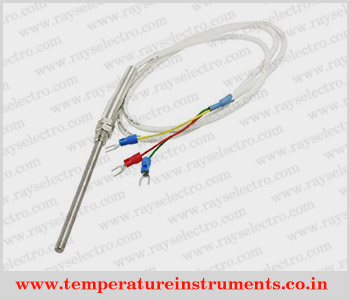Manufacturer of Pt-100 Temperature Sensor
We produce a wide range of PT-100 temperature sensors in Ahmedabad. PT-100 is a type of platinum resistance thermometer, made of platinum and known as PRT or “Platinum Resistance Thermometer”. PT-100 sensors have a resistance value of 100 ohms at 0°C, where PT refers to platinum (Pt) and 100 refers to 0°C sensors with a resistance of 100 ohms. Compared to other temperature measuring methods, PT-100 sensors have long-term stability and high accuracy (better than 0.2 ohm/0°C after one year). They come in different sizes to meet various client requirements and are widely used in various applications. Our PT-100 sensors are of high quality and competitively priced, making them a popular choice among clients. We offer accuracy specifications and various packaging options to suit most applications and client requirements. Furthermore, our products are available at the best possible rates.

We are an established company for manufacturing, supplying and exporting Pt-100 Temperature Sensor that common type of platinum resistance thermometer. Pt is the sensor is made from Platinum (Pt). 100 refers to that at 0°C sensor has a resistance of 100 ohms (Ω). A resistance thermometer is a type of temperature sensor. Our P-100 Temperature is a robust industrial probe which can be used in many applications. This sensor incorporates an in-head temperature transmitter with an industry standard 4-20mA output and selectable range. This allows easy integration into your existing process control equipment. One can use this sensor for measuring the temperature of liquids and gases across a wide temperature range of -75 to +250°C. We provide an easy-to-install sensor since it deducts pipe work or tanks and vessels using a suitable mounting such as a compression fitting or thermo pocket.
The working principle of the PT100 sensor is used to measure temperature that falls into a group called Resistance Temperature Detectors or RTDs. The key word is “Resistance” because a Pt100 measures temperature by using a resistance change to denote the temperature value. For a Pt100, the resistance at 0°C is 100Ω and at 100°C, it is 138.5Ω. Therefore, the resistance change for each degree Celsius change is 0.385Ω. Before understanding how the sensor works, it is worth looking at some of the terminology used as this is extremely useful to know when identifying a sensor. The sensor type, Pt100, indicates two important pieces of information about the sensor. The first part, Pt, is the chemical symbol for Platinum and this shows that the sensor is Platinum-based. The second part, 100, relates to the resistance of the device at 0°C. In this case 100Ω. There are several variations on this theme. Other materials can be used such as Nickel (Ni) and Copper (Cu) and different resistance values such as 50Ω, 500Ω and 1000Ω.
Features PT-100 Temperature Sensor
- Based on resistance measurement principle
- Sturdy construction
- Easy in maintenance
- Durability and reliability
- Fine finish
- User friendly in nature
PT100 Working Principle also known as RTD PT100 working principle even though platinum is a precious metal and therefore very expensive it gives the greatest linearity and stability of any other material. It also has the benefit of being extremely resistant to corrosion and chemical attack and is very stable at high temperatures. As well as being used in Platinum Resistance Thermometers, it is also used in some high-temperature thermocouples. The mass of Platinum used in manufacturing the sensing elements is extremely small so the cost is surprisingly low and only represents a small proportion of the total cost of the finished temperature probe.
